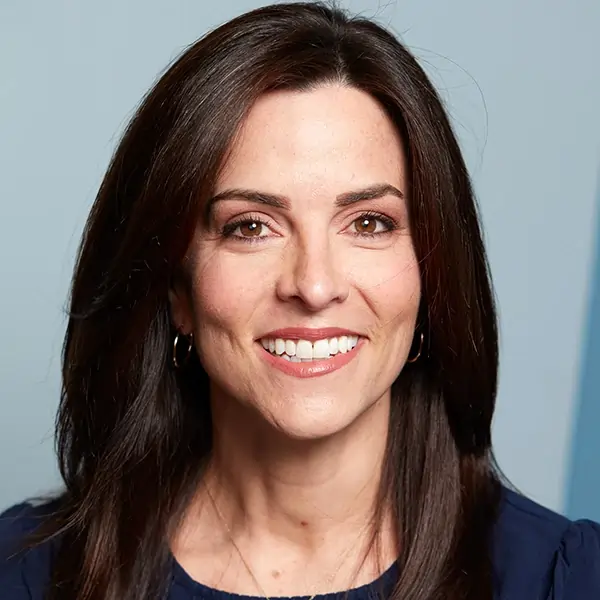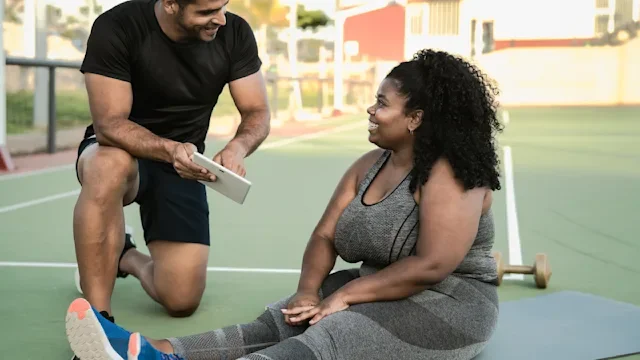Key takeaways:
People often set lofty, vague New Year's resolutions that are hard to achieve. Losing weight is a common one.
You can set many other fitness goals that have nothing to do with weight loss — and can help improve your health and well-being.
The best fitness goals are individually tailored. They should be specific, measurable, attainable, realistic, and time-bound (SMART).
Millions of people jump out of bed on January 1 with renewed enthusiasm for tackling a goal. As admirable as it is to aim for self-improvement, some of the most common health-related New Year's resolutions aren’t very effective. They tend to be vague, unrealistic, or irrelevant to the end goal of living a healthy, happy life. No wonder success rates are so low. According to some estimates, more than half of resolvers ditch their goals just one month into the new year.
Weight loss is one of the most common resolutions people make every year. But, if well-being is your real goal, weight loss isn’t the best way to get there, an October 2021 study suggests. It’s often more helpful to focus on specific shifts toward a healthier lifestyle –– like building muscle or eating more whole grains. These changes can offer a real longevity boost and help you increase your fitness without obsessing over the number on the scale.
"Health and fitness goals shouldn’t only be about your physical appearance. There are many things you can do to improve your overall health,” said Veronica Najera, master trainer for YogaSix in Sugar Land, Texas. "If you only think of cardio exercises in relation to the calories they burn, you might miss other important fitness targets, like strength and flexibility. Adding fitness routines with different goals can help you in the long run."
Search and compare options
Consider these expert-approved, long-term fitness goals for the new year and beyond. These fitness goals have nothing to do with losing weight. In fact, they focus on growth rather than loss. And these ideas are doable, beneficial, and even fun.
1. Move for at least 5 minutes every hour during the day
If an intense fitness goal like "run a marathon by June" feels too daunting, trainers suggest starting small. You can even start your short-term fitness goal right in your home or workplace. Block out 5 minutes in your calendar at the end of each hour throughout the day. Use that time to stand, walk, or perform your favorite stretches. This informal approach to moving more is called non-exercise activity thermogenesis (NEAT) in the fitness community.
Sitting for long periods can lead to all kinds of health problems and maybe even a shorter life span. So, regularly taking a few minutes to move around can make a big difference over time. The American Council on Exercise (ACE) reports that NEAT can help your body convert fat into energy, increase daily calorie expenditure, and boost energy levels.
2. Try one new workout every month
It's easy to give up on a workout plan if it starts feeling monotonous. Variety in your workout goals will keep your brain engaged and your body guessing. And this can boost your motivation and help you stick with your fitness routine.
"When your body gets used to the same routine, your mind isn’t challenged anymore and you can lose interest," Najera says. Plus, muscles grow when challenged by different or more demanding tasks. “Try something that you think is cool to up your enthusiasm.”
Here are some workouts you could try to help you mix things up:
Dancing
Swimming
Cycling or a drop-in class at a fitness studio
HIIT exercise or another cardio-endurance challenge
Yoga
Pilates
A sport you haven’t tried before
How to take more steps: Check out these research-backed tips to increase your daily step count.
Want bigger, stronger muscles? Experts weigh in on the best strategies to build muscle mass.
Ways to improve flexibility: Learn proven ways to increase flexibility for better functional mobility.
3. Aim for 7 hours of sleep per night
According to the CDC, 1 in 3 adults fall short of the recommended 7 or more hours of nightly sleep. And it’s not doing your health any favors. Research shows that insufficient or low-quality sleep can cause problems with heart health, weight, the immune system, and more. Plus, getting enough sleep may help prevent exercise plateaus and muscle loss, which can hinder long-term fitness goals.
Going to bed and getting up at the same time every day can make it easier to get the recommended 7 hours of sleep each night. You can also adjust your habits and environment to promote better sleep quality.
Try these expert-approved tips for better sleep:
Invest in a quality pillow, mattress, and bedding.
Install blackout curtains, or try a sleep mask.
Set the thermostat to around 65°F.
Wind down and go device-free for at least 30 minutes before bed.
Avoid caffeine in the afternoon and alcohol before bed.
Read more like this
Explore these related articles, suggested for readers like you.
4. Take 1,000 more steps per day, and work up to 7,500 steps
Walking can be an effective form of exercise. And doing enough walking every day has been shown to improve energy levels, boost heart health, and reduce the risk of Type 2 diabetes. Walking even reduced the total number of deaths from any cause among participants in one study. Though the scientific jury is still out on the ideal number of steps to take per day, roughly 7,500 steps may be the sweet spot for well-being. You can use a pedometer to track your step count.
Try to add 1,000 steps (about half a mile) to your current tally to reap the benefits of walking. Once you're comfortable with that new daily level, add 1,000 more. Keep doing this until you reach 7,500 steps or more per day.
5. Drink 0.5 oz of water for each pound of body weight
The CDC estimates that the typical adult in the U.S. drinks 44 oz of water per day, which is far less than the 91 oz for women and 125 oz for men recommended by the National Academies of Sciences, Engineering, and Medicine. Adequate water intake can support your workout performance and energy levels, Najera says. And staying hydrated by drinking water also helps your body to:
Maintain a normal temperature
Protect the joints, spinal cord, and other tissues
Eliminate waste
If 91 oz or 125 oz a day seems out of reach, you can try another approach. Brittany Rorie, senior master instructor for CycleBar in Charlotte, North Carolina, advises clients to customize water consumption to their current body size. She says, “Drink at least half an ounce of water for each pound that you weigh.” (For a person who weighs 160 lb, that means 80 oz, or 10 cups, of water per day.)
It’s important to ease into increasing your intake, though. That’s because it’s possible to drink too much water. If you have other medical conditions (like heart failure, for example), be sure to check in with a healthcare professional first.
Fitness goals that aren't focused on weight loss
"Weight loss becomes the message people hang on to,” Nitschke says, “because they've been told that’s what they need to do: Fit into a certain size or reach a specific weight to be desirable or even healthy.”
Genetics, age, and other factors can affect your weight in unpredictable ways. So, the truth is, your weight usually isn't entirely under your control. And your health is about so much more than the number on the scale. There are other important health indicators you can focus on instead, says Rorie. Building muscle, maintaining a balanced diet, and managing stress all play a crucial role in health, disease prevention, and longevity.
How do you choose the right fitness goals?
When setting a fitness goal, Nitschke recommends choosing something that’s relevant to your interests and lifestyle, personally meaningful, and not centered on weight. Your weight can change weekly, monthly, and yearly. When helping clients set health and fitness goals, Nitschke likes to ask them:
What do you see and feel when you close your eyes and imagine the best version of yourself?
What’s going on in your life right now, and how does that shape your goal?
How will you know when you're successful?"
"Living a balanced, harmonized life is not about the number on the scale,” Nitschke says. “The number on the scale is unreliable and reflects our relationship with gravity. Move more, enjoy who you are, and focus on trying to love who you are becoming in all phases of life."
Start by evaluating where you are and envisioning where you want to be. Then set a health and fitness goal accordingly. That goal should be inspiring and challenging, but not so difficult that it feels overwhelming, Rorie says. She advocates for "SMART" goals, which are:
Specific
Measurable
Attainable
Realistic
Time-bound
“There’s no ‘quick fix’ for your health," Rorie says. "If you're committed to developing a healthy lifestyle, that involves balance — not an all-or-nothing mentality."
Rorie adds, "In time, the results you're looking for will come. Worry less about the scale and more about consistency. The goal is to create a healthy lifestyle that’s sustainable long-term."
You aren’t a failure if you slip up on your health and fitness goals. You're human. So, reflect on what you can learn from the experience, decide whether or not your smart fitness goal could use some adjusting, and pick back up again the next day.
Frequently asked questions
The best cardio fitness goal is one that’s specific and suitable for your lifestyle and health needs. Here are some beginner-friendly examples of goals to help you build endurance and improve your fitness:
Climb 5 flights of stairs daily for 4 weeks.
Do at least 10 minutes of cardio 5 days a week for 6 weeks.
Power walk for 10 minutes after every meal for 6 weeks.
Go for a 5-mile bike ride twice a week for 8 weeks.
Train to run a 5K race in 12 weeks.
Experts recommend aiming for the following weekly exercise goals:
150 minutes of moderate cardio or 75 minutes of vigorous cardio
Two strength-training sessions that target major muscle groups
But you should set weekly exercise goals based on your current health and fitness level. For example, you might need to start with shorter, less-intense weekly cardio workouts if you're currently inactive.
The best cardio fitness goal is one that’s specific and suitable for your lifestyle and health needs. Here are some beginner-friendly examples of goals to help you build endurance and improve your fitness:
Climb 5 flights of stairs daily for 4 weeks.
Do at least 10 minutes of cardio 5 days a week for 6 weeks.
Power walk for 10 minutes after every meal for 6 weeks.
Go for a 5-mile bike ride twice a week for 8 weeks.
Train to run a 5K race in 12 weeks.
Experts recommend aiming for the following weekly exercise goals:
150 minutes of moderate cardio or 75 minutes of vigorous cardio
Two strength-training sessions that target major muscle groups
But you should set weekly exercise goals based on your current health and fitness level. For example, you might need to start with shorter, less-intense weekly cardio workouts if you're currently inactive.
The bottom line
The best health and fitness goals are designed to boost energy, strength, and overall wellness. Focus on targeted improvements to help you live a balanced, long life. Prioritizing weight loss may not be the best approach. As you work toward your goals, allow for flexibility and fine-tuning. And try to take note of achievements that aren’t related to weight. That could include being able to climb the stairs more easily, doing five more push-ups than you could before, or feeling rested when you wake up in the morning.

Why trust our experts?



References
Aghera, A., et al. (2017). A randomized trial of SMART goal enhanced debriefing after stimulation to promote educational actions. Western Journal of Emergency Medicine.
Armstrong, M. (2022). Top U.S. new year’s resolutions for 2022. Statista.
Banach, M., et al. (2023). The association between daily step count and all-cause and cardiovascular mortality: A meta-analysis. European Journal of Preventative Cardiology.
Centers for Disease Control and Prevention. (2024). About sleep and your heart health
Centers for Disease Control and Prevention. (2024). About water and healthier drinks.
Centers for Disease Control and Prevention. (2024). Fast facts: Data on water consumption.
Dickson, J. M., et al. (2021). Self-regulatory goal motivational processes in sustained new year resolution pursuit and mental well-being. Journal of Environmental Research and Public Health.
Gaesser, G. A., et al. (2021). Obesity treatment: Weight loss versus increasing fitness and physical activity for reducing health risks. iScience.
Garbarino, S., et al. (2021). Role of sleep deprivation in immune-related disease risk and outcomes. Communications Biology.
Knowles, O. E., et al. (2018). Inadequate sleep and muscle strength: Implications for resistance training. Journal of Science and Medicine in Sport.
Lee, I., et al. (2019). Association of step volume and intensity with all-cause mortality in older women. JAMA Internal Medicine.
McCall, P. (2017). 6 things to know about non-exercise activity thermogenesis. American Council on Exercise.
National Academies. (2004). Report sets dietary intake levels for water, salt, and potassium to maintain health and reduce chronic disease risk.
Papatriantafyllou, E., et al. (2022). Sleep deprivation: Effects on weight loss and weight loss maintenance. Nutrients.
Perry, A. S., et al. (2023). Association of longitudinal activity measures and diabetes risk: An analysis from the National Institutes of Health All of Us research program. The Journal of clinical Endocrinology & Metabolism.
Saint-Maurice, P. F., et al. (2020). Association of daily step count and step intensity with mortality among U.S. adults. JAMA.
Sylvester, B. D., et al. (2016). Variety support and exercise adherence behavior: experimental and mediating effects. Journal of Behavioral Medicine.
Ussery, E. N., et al. (2018). Joint prevalence of sitting time and leisure time physical activity among U.S. adults, 2015-2016. JAMA.
















